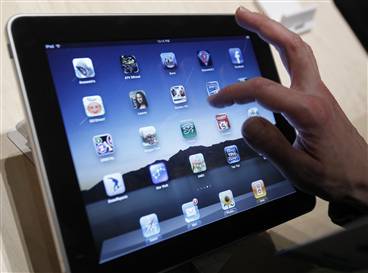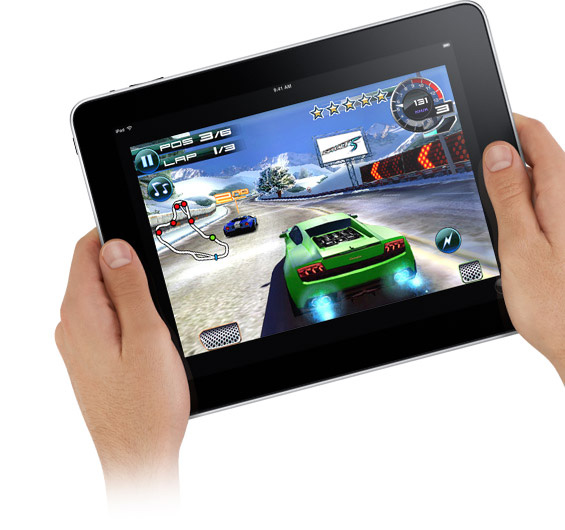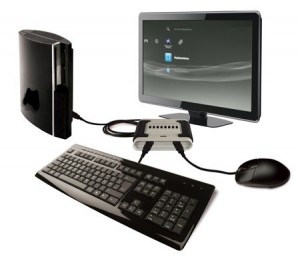iPad, with larger screen and faster processor than the iPhone and iTouch, could offer gamers the ultimate portable gaming device. With it’s 9.7-inch touchscreen display and other functionality ipad could be the batter choice for portable game lover.
Seemingly tailor-made for puzzle games, racing simulations and arcade amusements, Apple’s iPhone has quickly become a major player in the portable gaming market. But even with a staggering 30,000-plus downloadable diversions from “Dragon’s Lair” to “Flight Control” available, the device is about to face its stiffest competition yet.
Enter Apple’s own iPad, a tablet PC with wireless broadband connectivity and enough horsepower to directly compete with technically advanced gaming laptops. Still, one vital question remains unanswered: How the device plays with gamers themselves? The answer promises to define whether the iPad will prompt another gold rush for developers poised to shower enthusiasts with gaming riches (as Apple portends), or whether we’re still years off from striking the proverbial motherlode.
“There’s huge potential for games running on the faster processor and larger screen,” says John Davison, executive vice president of content for GamePro magazine. “The challenge is really defining that there’s a tangible need for a device that sits between a smart phone and a laptop. The onus is on Apple to prove that this is something we all must have”.
But from tiny independents to publicly-traded corporations, developers are already lining up to show their support for the platform, which is compatible with nearly all of the iPhone’s 140,000 apps. And game makers such as Pangea Software’s Brian Greenstone say that it’s a cinch to upscale existing apps’ visuals for the device.
Other notable proponents include Electronic Arts and Gameloft, which plan to issue upgraded versions of racing game “Need for Speed: Shift” and sci-fi first-person shooter “N.O.V.A.,” respectively .Both titles will sport enhanced graphics and multi-touch controls.
Though the iPad lacks features such as gesture-tracking cameras and dedicated 3-D video cards, the Wi-Fi-enabled iPad does add support for 3G wireless broadband access, in-game purchases and motion-sensitive commands. Offering more brawn than the DSi or PlayStation Portable, greater room for creative and financial experimentation than set-top consoles such as the Wii, Sony’s PlayStation 3 or Xbox 360, industry insiders marvel at the potential. Likewise, advocates say it has two things going for it that other devices don’t: Apple’s user-friendly app store and a massive range of current software support.
“Given the incredible start that the iPhone’s had and amount of existing games that the iPad can play, you have to stand up and take it seriously,” explains Martyn Brown, co-founder of “Worms” creator Team17. “Just as the Wii brought casual gaming home, I reckon that this will do the same for mobile gaming as well. The team’s been buzzing since the announcement. We can’t wait to get our ‘Worms’ title on it for launch.”
Similar sentiments are echoed by Gas Powered Games head Chris Taylor, creator of “Supreme Commander,” who downplays the system’s mid-range technical specifications. Rather than the hardware itself, he sees the ease of software purchases and downloads being the iPad’s Trojan horse into gamers’ monthly budgets. The gadget’s added screen size and visibility are nothing to sneeze at either, he says, explaining that it’s an “almost perfect machine” for running titles typically best confined to PCs, such as real-time strategy games.
Still, Taylor suspects that most major PC and console developers won’t dive in immediately, though. He predicts studios will adopt a wait-and-see approach until there’s a large install base for the device, and hence, money to be made.
Slick and sleek as it is, the iPad isn’t cheap. The device, which ships in late March and retails for $499 and up, is $200-$300 more than hand-held game consoles such as the Nintendo DS or the Sony PSP, and $100-$150 beyond traditional netbook computers. This may cost Apple in the end. Sony’s PS3 also launched at $499 and up — and didn’t hit its stride at retail until prices dropped below $299. And game developers, already reeling from recessionary realities, may balk at producing for yet another hardware platform.
Indeed, the iPad’s limited pricing structure (most titles will retail for $9.99, versus $50-60 for traditional PC or console platforms) make it a risky investment for traditional publishing houses, analysts say. Because games won’t sell for as much as they do on next-gen consoles, they may not be worth the time, effort and expense to develop. Popular franchises like “Call of Duty” and “Grand Theft Auto” will probably only make token appearances on the iPad, says Jesse Divnich, an analyst with Electronic Entertainment Design and Research. Killer apps, let alone platform exclusives, will be few and far between, he predicts, with hastily done ports more commonplace, ensuring that the iPad will “never be a primary gaming device” like the DS or PSP Go.
Todd Howard, Bethesda Game Studios’ game director, agrees. “Compared to the iPhone, it’s a much better hardware platform, and racing games, shooters and strategy titles should directly benefit from under-the-hood improvements.” But for now, he also says the iPad, with its smaller audience and limited tech specs compared to traditional consoles, won’t be viewed by large studios, except dedicated mobile game providers, as more than a distraction.
Luckily for Apple, salvation may come in the form of its existing faithful — a legion of loyal bedroom coders who’ve found overnight success in the iPhone, which shares an operating system with the iPad. Witness Steve Demeter, creator of popular puzzler “Trism,” which netted him a cool $250,000 in just two months. Sequel “Trism 2” will arrive in an enhanced iPad version featuring sharper graphics, higher resolutions and more extensive multiplayer support this fall, he says, simultaneously alongside its iPhone/iPod Touch cousin.
Demeter also applauds Apple’s move to maintain compatibility with the existing iPhone OS. Not only does this ensure there’s no need to start your software collection from scratch, it also presents a simple matter for developers to upscale game visuals, which are often originally created at higher resolutions, then downgraded to run at the iPhone’s inferior specs.
Visit msnbc.com for breaking news, world news, and news about the economy
But at this point, there are still more questions than answers when it comes to the future of gaming on the iPad. To wit: How well can touchscreen controls on existing iPhone games, designed for use with a smaller monitor and different finger layout, translate to the iPad’s larger display? Are cash-strapped shoppers really willing to pony up $500 minimum for an unproven device category that’s besieged on both ends by increasingly powerful smartphones and falling prices on premium laptops? And, in the end, will Apple sell enough of the devices to convince game makers to take the hardware seriously, let alone feel compelled to raise the bar? Only time will tell, but experts agree: Apple’s got a lot riding on its latest play.
“This isn’t a gaming device — it’s a digital device that can play games,” says GamePro’s Davison. “Apple is selling a change in behavior here. People tend to play games in one of three ways: On a console, their laptop/PC or via hand-helds. [Gamers] need to see a good reason to fit the iPad in with that routine, or have it switch out with one of them. But it certainly stands a good chance of becoming a go-to casual gaming device.”
Source: MSNBC





